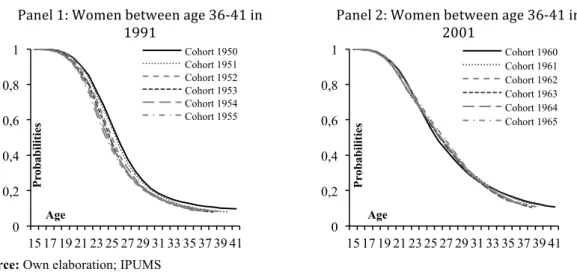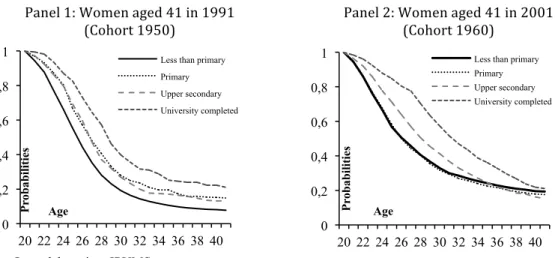and its impact in the transition to motherhood
Lídia Patrícia Tomé1 & Maria Filomena Mendes2
Extended Abstratct3
Key words: Fertility, Cohort reconstruction, education.
Background and motivation
We assist in the European societies to a considerable improvement in the educational system and in the requalification of the labour market as result of higher educational levels. That evolution had change the female participation in the educational and labour markets, and as result the transition to motherhood has been postponement and the number of births declined. Thus the relationship between educational attainment, and the transition to motherhood has been an important topic of discussion in the literature (e.g. Hoem et all 2006; Lappegård & Rønsen 2005; Martín-‐García & Baizán 2006; Tesching, 2012.)
Traditionally that relationship study is in the perspective of how a woman’s education affects her childbearing behaviour. Empirical investigations have focused not only on the impact of female education on the level of childlessness or the ultimate number of children, but also on educational differentials in the timing and spacing of births (Tesching, 2012). Less attention has been given to two other possibilities, first is that not just the education of a woman influences her childbearing behaviour, the birth of a child might also lead to changes in her educational career; second, and although researchers have frequently argued that the relationship between fertility and education is extremely complex, little attention has been given to the possibility that the connections in the period and cohort have different dynamics.
Influenced by the social and economic contexts and transformations, the educational level and the motherhood timing play a central role in shaping the life courses trajectory. E.g. in countries, such as Italy, Portugal or Spain, the massification in the access to educations in the 1960’s and the explosion of female higher education seems to result in the significant postponement and decline of fertility.
Once that is expected to observe different behaviours between different cohorts, the goals of the current research are, (1) to reconstruct life courses events for five European selected countries (Austria, Greece, Hungary, Portugal and Spain) using for that IPUMS samples; (2) elaborate cohort life fertility tables to analyse the transition to motherhood; and (3) observe the impact of educational levels in the cohort fertility.
1
PhD Student at the University of Évora, CIDEHUS.UE (FCT -‐ SFRH/BD/70494/2010) & Guest Researcher at the Max Planck Institute for Demographic Research. Email: lidiap_tome@hotmail.com
2 Associate Professor in the Department of Sociology at the University of Évora and Researcher at CIDEHUS.UE Email: mmendes@uevora.pt
Data and methods
For the analysis of transition to motherhood it will be use fertility table methods (Chiang 1984). The analyses of survival curves are the result of data reconstruction of several cohorts by educational levels in the years of 1991 and 2001 using for that IPUMS database, for five European countries – Austria, Greece, Hungary, Portugal and Spain. The data used is the IPUMS census samples of 5% (Hungary, Portugal and Spain) and 10% (Austria and Greece) sample of the population in each one of the countries. Each one of the mentioned samples covers standard socio-‐demographic characteristics such as age, nationality, educational attainment, region of residence, household composition, etc. With such data was possible to reconstruct the motherhood transitions and complete fertility patterns. To have a homogenous sample that allowed to reconstruct cohort fertility and, to reconstruct the transition to motherhood by the educational level, we restrict our analysis to the birth cohorts born later than 1950. Furthermore we restrict to birth cohorts between 1950-‐1960, combining from the samples, mothers aged 40 at the census time in1991 and in 2001.
Preliminary Results – The specific case of Portugal
Before we can compare the differences between countries and transition moments, it was our goal to observe the evolution of the proportion of females exposed to the event (transition to motherhood by educational level) in two different cohorts (1995 and 1965). In figure 1 is possible to observe the differences within cohorts and countries, differences. Such differences are the result of social and economic transformations distinctive for each cohort. In comparison to the other countries, if we focus our attention in the Portuguese case, is possible to identify a massif representation of females unschooled, with special attention to the 1955 cohort, were this group represented more than 6%.
Figure 1: Evolution of proportion of females exposed to transition to motherhood by educational level, in the selected countries and for 1955 and 1965 cohorts
Austria Greece Hungary Portugal Spain 1955 1965 1955 1965 1955 1965 1955 1965 1955 1965 20% 40% 60% 80% 100%
two groups of cohorts, 1950-‐1955 (women between 36-‐41 in 1991) and 1960-‐1965 (women between 36-‐41 in 2001). For the cohorts 1950-‐1955 (figure 2, panel 1) we observe a decrease in the median age at first child (i.e., the age at which 50% of the respondents become mothers). For the cohorts 1960-‐1965 (figure 2, panel 2) the exact opposite situation is observed, with the increase of the mean age. Between cohorts born in 1950-‐1955, the decline was from 27 (1950 cohort) to 24 (1955 cohort) years, while for the cohorts 1960-‐1965 the increase in the median age was smaller, from 25 in 1960 cohort to 26 years in 1965 cohort.
Figure 2: Transition to motherhood for women between age 36-‐41 in 1991 (1950 cohort) and 2001 (1960 cohort)
Panel 1: Women between age 36-‐41 in
1991 Panel 2: Women between age 36-‐41 in 2001
Source: Own elaboration; IPUMS
In Figure 3 (panel 1 and 2) we have the probabilities for the transition to motherhood by final educational level for the birth cohorts of 1950 and 1960. There we can observe that the median age by education level, increased between the two cohorts in observation and within the educational levels. The evolution of transition to motherhood presented similar behaviours between the different levels of education. Between the two cohorts is also possible to observe that with 25% of probabilities of having a child, is the University level the one with higher ages. While at age 35, 25% of women from birth cohort 1950 were still childless, for birth cohort 1960 the same situation occurred only at age 38. Between the women with primary level of education and upper secondary, the differences are tenuous. For the birth cohort of 1950 the difference is equal to 1 year between the two levels of education when regarding the 25% of childless women. For the birth cohort of 1960, the differences are around 3.5 years.
Resuming, we can say that, in a general way, are the mothers with the University level that enter into motherhood latest in time, and the unschooled ones the youngest mothers. The only difference between the two cohorts is that women from the 1960s cohort with Primary education present almost identical patterns when compared with the unschooled ones.
0 0,2 0,4 0,6 0,8 1 15 17 19 21 23 25 27 29 31 33 35 37 39 41 P rob ab il iti es Age Cohort 1950 Cohort 1951 Cohort 1952 Cohort 1953 Cohort 1954 Cohort 1955 0 0,2 0,4 0,6 0,8 1 15 17 19 21 23 25 27 29 31 33 35 37 39 41 P rob ab il iti es Age Cohort 1960 Cohort 1961 Cohort 1962 Cohort 1963 Cohort 1964 Cohort 1965
Figure 3: Transition to motherhood by educational level for women aged 41 in 1991 (1950 cohort) and 2001 (1960 cohort)
Panel 1: Women aged 41 in 1991 (Cohort 1950)
Panel 2: Women aged 41 in 2001 (Cohort 1960)
Source: Own elaboration; IPUMS
Our preliminary results regarding Portugal are fairly conclusive, are they were used here as an example. Preliminary exercises, not presented here reveled that e.g. in the cohort of 1965 Spain was the country with higher postponement while in 1955 Austria was the one with low postponement followed by an marked delay of fertility after age 26.
The research plans for this project are, as discussed above, to include at least the following three extensions:
(1) Reconstruct life courses events for five European selected countries with low period fertility rates -‐ Austria, Greece, Hungary, Portugal and Spain.
(2) Elaborate cohort life fertility tables to analyse the transition to motherhood.
(3) Observe the impact of educational levels in the cohort fertility patterns, with the aim to identify the differences between countries and cohorts.
References
Chiang C. (1984), The life table and its applications, Robert e. Krieger publishing company,
inc.
Hoem, J.M., Neyer, G. & Andersson, G. (2006),. Education and childlessness: The
relationship between educational field, educational level, and childlessness among Swedish women born in 1955-‐59. Demographic Research 14 (15).
Lappegård, T. & Rønsen , M. (2005), The multifaceted impact of education on entry into
motherhood. European Journal of Population 21.
Martín-‐García, T. & Baizán, P. (2006), The impact of the type of education and of
educational enrollment on first births. European Sociological Review 22 (3).
Tesching, K., (2012), Education and fertility: dynamic interrelations between women’s
educational level, educational field and fertility in Sweden. Stockholm: Stockholm 0 0,2 0,4 0,6 0,8 1 20 22 24 26 28 30 32 34 36 38 40 P rob ab il iti es Age
Less than primary Primary Upper secondary University completed 0 0,2 0,4 0,6 0,8 1 20 22 24 26 28 30 32 34 36 38 40 P rob ab il iti es Age
Less than primary Primary Upper secondary University completed
ABSTRATCT
The relationship between educational attainment, and the transition to motherhood has been an important topic of discussion in the demographic context. Influenced by the social and economic contexts and transformations, the educational level and the motherhood timing play a central role in shaping the life courses trajectory. E.g. in countries, such as Italy, Portugal or Spain, the extensive access to educations since the 1960’s and the explosion of higher educated female seems to result in the significant postponement and decline of fertility and remarkable differences among cohorts. If is expected to observe different behaviours between different cohorts, the goals of the current research are, (1) reconstruct life courses events for five European selected countries (Austria, Greece, Hungary, Portugal and Spain) using for IPUMS samples; (2) elaborate cohort life fertility tables to analyse the transition to motherhood; and (3) observe the impact of educational levels in the cohort fertility patterns.


